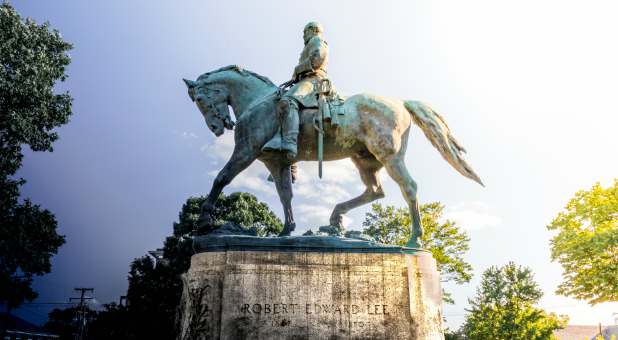Tearing Down Our Monuments to Racism
A 93-year-old statue of Confederate General Robert E. Lee triggered the ugly protest that erupted in Charlottesville, Virginia, on Aug. 12. White nationalists and KKK members marched through the city to protect the statue; counter-protesters demanded that it be removed. In the end, three people died in the violence—including a woman who was run over by a white supremacist’s car.
What happened in Charlottesville is likely to happen elsewhere. There are approximately 1,500 Confederate monuments in the United States—in front of courthouses and libraries, in parks, on campuses and even carved on a granite mountain near Atlanta. For some people, these monuments are harmless tributes to dead soldiers; for others, they are offensive reminders of slavery and white pride.
Over the past few years local governments have been removing Confederate statues in an effort to be more racially sensitive:
- In Tampa, Florida, a Confederate monument is being relocated from a courthouse to a cemetery
- Four statues of Confederate soldiers have been removed from public view in New Orleans
- Busts of Confederate Generals Robert E. Lee and Stonewall Jackson have been removed from the Hall of Fame of Great Americans in New York
- The city of Annapolis, Maryland, has removed a 145-year-old statue of Chief Justice Roger Taney, who wrote the 1857 Dred Scott Decision. (His ruling said slaves were not citizens of the United States and therefore were not protected by law.)
- A statue of a Confederate soldier named “Old Joe” was peacefully removed from courthouse grounds in Gainesville, Florida, and will be relocated
- After the violence in Charlottesville, the mayor of Baltimore quickly ordered four Confederate statues removed from city property.
Similar removals and relocations of Confederate statues, obelisks and memorials are in process in Missouri, Kentucky and Texas. Meanwhile in Durham, North Carolina, a group of rowdy protesters pulled down a Confederate statue and broke it on Aug. 14. They could be seen on video kicking the image as they sang and cheered.
Also last week, the mayor of Birmingham, Alabama, covered a prominent Confederate monument with a tarp and erected a plywood structure around it—prompting the state’s attorney general to file suit against the city. Mayor William Bell defended his actions by saying: “The God I know doesn’t put one race over another.”
Welcome to America 2017. We are still a nation divided. But we cannot let our memories of the first Civil War trigger a second one. Here are three principles that should guide us during this season of soul-searching:
- Let’s be willing to let go of the past. I’m a Southerner. I was born in Louisiana, and I spent my boyhood in Alabama and my teenage years in Georgia. I even had an ancestor who died fighting for the South. But I’m not a Confederate; I’m an American. And my black and immigrant friends will assure you I’m not a racist.
I don’t need a Confederate memorial to remind me of my heritage; my identity is in Jesus Christ, not in the South. I should be more concerned with loving my African-American friends than in protecting or preserving my white heritage. I totally understand why black people feel oppressed by Confederate flags or statues of Civil War soldiers. Instead of being offended by their feelings, I should empathize with them.
- Let’s be respectful to each other in the process. The young protesters in Durham, North Carolina, tied a rope around a Confederate statue and pulled it down. Then they kicked it and spit on it as they chanted, “We are the revolution.” Seven of those protesters are now under arrest for inciting a riot and for damaging public property. Angry mobs will not heal America’s racial problems. If we want to overcome hate, we have to do it decently—and with the same commitment to non-violence that Rev. Martin Luther King Jr. espoused in the 1960s.
Let’s not be foolish. We can’t put out fire with fire. Vigilante vandalism is not the way to heal this country. I don’t support the message of a Confederate statue, but neither do I support the hateful, vindictive ways some people today are trampling on history. We shouldn’t let mobs smash the statues. They should be moved from their pedestals of prominence and put in museums where future generations can ponder our mistakes. (And I would suggest that when they are removed, ministers should be there to publicly repent for our racist sins against each other.)
- Let’s be aware of spiritual realities behind our icons. The Bible says most of Israel’s kings refused to tear down the “high places” of idol worship that had been set up by the Canaanites. Only King Hezekiah and King Josiah had the moral courage to fully tear down these pagan structures (see 1 Kings 15:14, 2 Kings 18:4). There is no question that our country has tolerated a spiritual stronghold of racism; is it possible that these stone memorials of Civil War “heroes” have helped keep our nation divided?
As a Christian, and as a Southerner named Lee (yes, my 90-year-old father was named after two Civil War generals), I believe it’s time to put our ugly past behind us. We will do that not simply by removing offensive monuments but also by asking Jesus to break the power of racism if it still has a place in our hearts.
















































